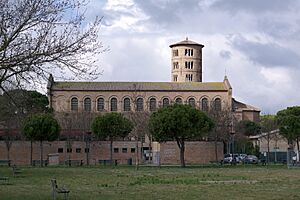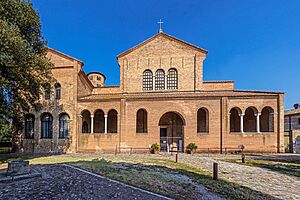Basilica of Sant'Apollinare in Classe facts for kids
Quick facts for kids Basilica of Saint Apollinaris in ClasseBasilica di Sant'Apollinare in Classe |
|
|---|---|

The Basilica of Sant'Apollinare in Classe
|
|
| Religion | |
| Affiliation | Catholic |
| Province | Archdiocese of Ravenna-Cervia |
| Region | Emilia-Romagna |
| Year consecrated | 549 |
| Location | |
| Location | Classe, Ravenna, Italy |
| Architecture | |
| Architectural style | Byzantine architecture |
| Groundbreaking | Early 6th century |
| Official name: Early Christian Monuments of Ravenna | |
| Type | Cultural |
| Criteria | i, ii, iii, iv |
| Designated | 1996 (20th session) |
| Reference no. | 788 |
| State Party | Italy |
| Region | Europe and North America |
The Basilica of Sant'Apollinare in Classe is a very old church in Classe, Ravenna, Italy. It was officially opened on May 9, 549. The church is named after Saint Apollinaris, who was the first bishop of Ravenna and the nearby town of Classe.
This church is a great example of ancient Roman and Byzantine art. In 1996, it became a UNESCO World Heritage List site. UNESCO said it was an amazing example of an early Christian church. They noted its simple design and beautiful decorations.
Contents
History of the Basilica
Work on the Basilica of Sant'Apollinare in Classe began in the early 500s. Bishop Ursicinus ordered its construction. A rich Roman banker named Iulianus Argentarius paid for it. The church was built near an old Christian burial ground. Some old tombstones were even reused in its walls.
Back then, Classe was a port city right on the coast. It was home to the Roman fleet. Over many years, dirt and sand built up. This caused the coastline to move about 9 kilometers (5.6 miles) east. So, the church is now much further from the sea.
The church is made of strong brick. Bishop Maximian officially opened it on May 9, 549. It was built around the same time as the famous Basilica of San Vitale in Ravenna. Today, the bones and important items (relics) of Saint Apollinaris are kept inside this church.
In the 1400s, a ruler named Sigismondo Malatesta took some marble from the church. He used it to build another church in a different city.
Church Design and Art
Outside the Church
The front of the church is quite simple. It has two tall, straight walls and a window with three openings. The entrance area and the building on the right were added later. The tall, round bell tower was built in the 800s. It has windows with multiple openings.
This bell tower is the tallest in Ravenna. It was added to the church in the late 900s.
Inside the Church
The church has a main area called a nave. On each side of the nave are two smaller aisles. This is a common design for a basilica. In the middle of the nave, there is an old altar. It marks the spot where Saint Apollinaris is believed to have died for his faith. The church ends with a rounded section called an apse. Two smaller chapels are on either side of the apse.
The nave has 24 columns made of Greek marble. The tops of these columns have carvings of acanthus leaves. These leaves look like they are twisting in the wind. Faded paintings on the side walls show some of Ravenna's past bishops. These paintings are from the 1700s. The side walls used to have beautiful mosaics. However, these were likely removed by people from Venice in 1449. Luckily, they left the amazing mosaics in the apse and on the arch leading to it. These are the most striking parts of the church.
The upper part of the arch has a picture of Christ in a circle. On the sides, in clouds, are symbols of the four writers of the Gospels: an Eagle (for John), a Winged Man (for Matthew), a Lion (for Mark), and a Calf (for Luke). The lower part of the arch shows walls decorated with jewels. From these walls, twelve lambs appear. These lambs represent the Twelve Apostles. On the sides of the arch are two palm trees, which symbolize justice. Below them are the archangels Michael and Gabriel. There is also a picture of Saint Matthew and another saint.
The artwork in the apse was created in the 500s. It has two main parts:
- The top part shows a large circle with a starry sky. Inside the circle is a cross covered in jewels. Above the cross, a hand reaches out from the clouds. This is known as the Hand of God. On the sides of the circle are the figures of Elijah and Moses. Three lambs below them represent Saints Peter, James, and John. This scene reminds us of the Transfiguration of Jesus on Mount Tabor.
- The bottom part shows a green valley with rocks, bushes, plants, and birds. In the middle is Saint Apollinaris. He is shown praying to God for his followers, who are represented by twelve white lambs.
The choice of these pictures was important at the time. It helped to teach about both the divine (God-like) and human sides of Christ. It also showed that Maximian was a true leader, just like Apollinaris was the first bishop.
Between the windows are pictures of four bishops. They founded the main churches in Ravenna. These bishops are Urscinus, Ursus, Severus, and Ecclesius. Each holds a book. On the sides of the apse are two panels from the 600s. The left one shows the Byzantine Emperor Constantine IV giving special rights to a messenger from Ravenna's archbishop. The right panel shows Abraham, Abel, and Melchisedek around an altar. They are offering a sacrifice to God.
The walls of the Basilica are lined with many stone coffins called sarcophagi. These coffins show how art styles changed from the 400s to the 700s. You can see how human figures changed to Byzantine symbols. Then, these symbols became simpler and more abstract over time.
Images for kids
-
Mosaic panel of Emperor Constantine IV granting privileges to the Church of Ravenna












